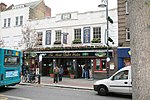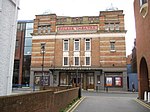Holy Rood Church, Watford
20th-century Roman Catholic church buildings in the United KingdomBuildings and structures in WatfordChurches in HertfordshireChurches in the Roman Catholic Diocese of WestminsterGothic Revival architecture in Hertfordshire ... and 6 more
Gothic Revival church buildings in EnglandGrade I listed Roman Catholic churches in EnglandGrade I listed churches in HertfordshireHistory of WatfordRoman Catholic churches completed in 1900Roman Catholic churches in Hertfordshire

Holy Rood Church is a Roman Catholic Parish church in Watford, Hertfordshire. It was built from 1889 to 1890. It is situated on the western corner of Market Street and Exchange Road. It was designed by John Francis Bentley, who also designed Westminster Cathedral. It is a Grade I listed building. The church features in England's Thousand Best Churches by Simon Jenkins who described it as "a true town church".
Excerpt from the Wikipedia article Holy Rood Church, Watford (License: CC BY-SA 3.0, Authors, Images).Holy Rood Church, Watford
Market Street,
Geographical coordinates (GPS) Address External links Nearby Places Show on map
Geographical coordinates (GPS)
| Latitude | Longitude |
|---|---|
| N 51.6548 ° | E -0.3986 ° |
Address
Holy Rood
Market Street
WD18 0PX
England, United Kingdom
Open on Google Maps








